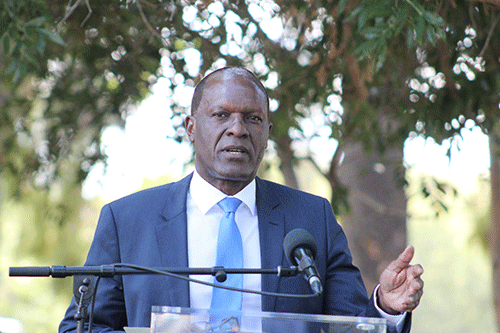NKURENKURU – Mines and energy minister Tom Alweendo last week handed over completed electrification projects in the Kavango West region.
These projects were completed in collaboration with NamPower at a total cost of N$11 million.
“These electrification projects are a testament to our government’s commitment to rural electrification and the realisation of the Harambee Prosperity Plan II, which aims to electrify all clinics and schools by 2025,” Alweendo said at Bravo San community settlement in the Mpungu constituency.
The minister applauded the remarkable collaboration between his ministry and NamPower. “Together, we have delivered much-needed electrification services to our rural communities. Today, we are witnessing the transformative power of unity and determination. We began these electrification projects in the Kavango West region in 2020 during the height of the Covid-19 pandemic,” he said.
“We managed to complete the projects in July 2023, and it has been made possible due to the spirit of cooperation between two government agencies,” he added.
The partnership between the ministry and NamPower has succeeded through their shared commitment to improving the lives of Namibians and bridging the gap between urban and rural areas. Together, they have electrified schools, community halls, boreholes, business centres, churches and police checkpoints across various constituencies within the country, and also in the Kavango West region.
Last week’s official handover saw four primary schools in the Tondoro constituency electrified, namely Mantete, Naimanya, Mpungu and Kaparara.
“In the Musese constituency, we brightened the future of our youths by electrifying the Mpanda Junior Primary School and providing an electricity access point for local businesses at Mpanda,” the minister continued. The completion of this project in September 2021 opened doors to new opportunities.
In the Nkurenkuru constituency, they electrified the Mungomba Junior Primary School, two boreholes, two churches, and a connection point for a business centre in September last year.
In the Mpungu constituency, the partnership electrified the Namasira police checkpoint, while the access point for the business centre was completed in February 2023.
In the Kapako constituency, the electrification of a community hall was completed in February 2023, now standing as a symbol of progress in the area. “These electrification projects were funded directly by NamPower, and I want to extend our heartfelt gratitude to the NamPower team, led by Simson Haulofu, for their dedication and oversight during the installation,” Alweendo said.
“However, there are other projects that have been funded by the Ministry of Mines and Energy and supervised by NamPower. For example, in the Mpungu constituency, four primary schools— Mpotomutarara, Kandumbu, Nandingwa and Mukekete—along with teachers’ houses and an outreach clinic at Nandingwa as well as business centres at Mpotomutarara, Mukekete, Nandingwa and Kandundu villages, were electrified,” he continued.
“The project also saw the Nairenge Primary School being electrified, along with a borehole, and a connection point for the business centre was commissioned in February 2023. We have provided electricity to the Suni Primary School, and their borehole,” Alweendo noted.
Kavango West governor Sirkka Ausiku wants more.
“The region is having mixed feelings today. Although we appreciate the implementation of these 14 projects, statistics are telling us a different story,” she said while reminding the nation that Kavango West is statistically the poorest region and needs attention to change the status quo.
Ausiku stressed that the region is highly rural, and the provision of rural electrification is still a challenge. “The region is failing to understand why there is the huge backlog of 34 schools not yet electrified,” she observed whilst welcoming Alweendo.
Ausiku further questioned the minister why most of the identified growth points or ‘big villages’ in the region, including the settlements comprising Mpungu, Rupara, Bunya, Ncamagoro, Katjinakatji, Tondoro, Mururani, Ncuncuni and Ncaute were not yet electrified, as they are key to the region’s development.
“In the case of Rupara, it has 97 houses under the Shack Dwellers Federation of Namibia which are not yet electrified, as well as no water provision,” she said.
Ausiku reiterated her appeal to the mines and energy minister and other ministries and their public enterprises that in planning, they should be guided by the available statistics when allocating resources to regions to achieve prosperity for all Namibians.


